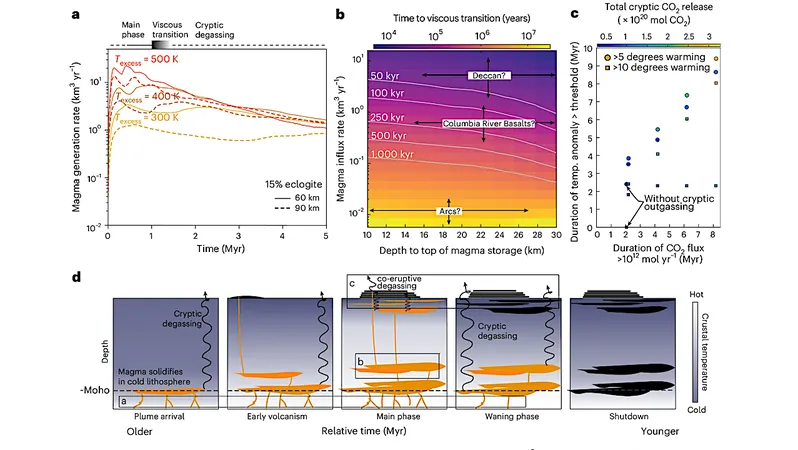
Unveiling a Hidden Climate Driver: Ancient Volcanoes Released CO2 Long After Eruptions
2024-10-31
Author: Sarah
An international team of geoscientists, spearheaded by a volcanologist from Rutgers University-New Brunswick, has unearthed a groundbreaking discovery: ancient volcanoes continued to emit carbon dioxide from deep within the Earth long after their surface eruptions had ceased, challenging established scientific beliefs. This revelation sheds light on the enigmatic climate shifts during pivotal moments in Earth's history.
The study, published in the recent issue of Nature Geoscience, highlights the significance of these ancient volcanic activities. "Our findings reveal a previously hidden source of CO2 that contributed to prolonged warming in Earth's past, suggesting a more complex story about climate disruptions and recoveries,” says Benjamin Black, the study's lead author and an associate professor in Earth and Planetary Sciences.
This new information is particularly relevant in today's context, as human activities produce far more carbon emissions than all of Earth's volcanoes combined. However, understanding how Earth's natural systems could assist in climate recovery when human emissions decrease is a crucial insight. "Earth has natural climate regulation systems – akin to a thermostat,” Black explains. “However, we need to ask if there are critical thresholds beyond which these systems malfunction, hindering recovery.”
Scientists have long been perplexed by the sluggish recovery of Earth's climate following the end-Permian mass extinction event, which occurred 252 million years ago and resulted in unparalleled biodiversity loss. This extinction has been linked to cataclysmic volcanic eruptions in Siberia. Despite the eruption ceasing, the planet's climate took almost five million years to stabilize. “The delay in recovery puzzled many scientists; it seemed as though Earth’s natural thermostat had malfunctioned,” Black notes.
The research team explored the geological records from various times of significant volcanic activity and discovered consistent evidence of carbon dioxide emissions persisting for millions of years after surface eruptions ceased. This insight was gleaned through chemical analyses, computer simulations, and comparisons with preserved sedimentary climate records.
They termed this phenomenon “cryptic carbon,” referring to CO2 emissions from magma deep within the Earth's crust and mantle. “It’s as if the volcanoes were releasing carbon from beyond the grave,” Black said, emphasizing how significant these findings are for understanding past climate events.
Interestingly, if these ancient volcanoes indeed contributed to the sustained warming during those times, it may indicate that Earth’s natural climate control systems are more resilient than previously assumed. “If this hypothesis holds, it signifies potential good news for future climate recovery after human-induced warming,” Black remarked.
Notably, Black cautioned that the volcanic activities being studied cannot account for current climate change. The type of volcanism involved, capable of generating enough magma to blanket the continental USA, hasn't happened in the last 16 million years. Present-day volcanic activity contributes less than one percent of the carbon emissions compared to human activities.
Nonetheless, scientists believe that studying these past volcanic events can provide insights into current and future climate dynamics. These ancient eruptions represent some of the few occurrences in Earth's history where carbon was released at scales comparable to today’s emissions.
The study marks the beginning of a long-term initiative funded by the National Science Foundation aimed at exploring how "cryptic carbon" may influence the Earth's recovery following substantial climate disruptions. This summer, the research team ventured into northeastern Oregon, a site known for its historical volcanic activity linked to climate warming 16 million years ago. Scientists collected samples from the Wallowa Mountains, home to extensive magmatic dikes—which are remnants of volcanic activity that provide critical insights into Earth’s geological past.
With climate change being a pressing global issue, these revelations about ancient volcanic activity could not only reshape our understanding of geological history but also guide future efforts in managing and mitigating climate impacts on Earth. As we continue to unravel these geological mysteries, one thing remains clear: our planet's history holds valuable lessons for our climate's future.



 Brasil (PT)
Brasil (PT)
 Canada (EN)
Canada (EN)
 Chile (ES)
Chile (ES)
 España (ES)
España (ES)
 France (FR)
France (FR)
 Hong Kong (EN)
Hong Kong (EN)
 Italia (IT)
Italia (IT)
 日本 (JA)
日本 (JA)
 Magyarország (HU)
Magyarország (HU)
 Norge (NO)
Norge (NO)
 Polska (PL)
Polska (PL)
 Schweiz (DE)
Schweiz (DE)
 Singapore (EN)
Singapore (EN)
 Sverige (SV)
Sverige (SV)
 Suomi (FI)
Suomi (FI)
 Türkiye (TR)
Türkiye (TR)